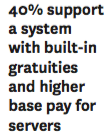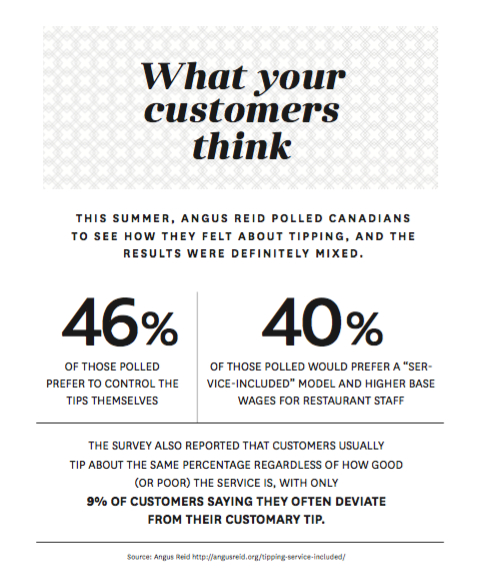The Tipping Revolution
Some customers love it, some don’t. Many operators don’t like it, but most servers seem happy with things the way they are. The subject is tipping, and the status quo might be changing soon.
This summer, I spoke to two Canadian pioneers in the no-tipping movement: David Jones of Vancouver Island’s Smoke ‘N Water, and Bill Sweete of Sidecar in Toronto. While their reasons for eliminating tipping were similar, their experiences—and outcomes—were quite different.
Why did you eliminate tipping?
Both owners agreed tipping was a model that didn’t work. Sweete identified three problems with the system:
1. Restaurant owners have little control over compensation when tipping comprises such a big part of take-home pay. He’d prefer to reward the work that’s important to him as a business owner, which is sometimes invisible to (or doesn’t matter to) customers.
2. When servers are paid by tips rather than income, they receive less EI, vacation pay, or CPP coverage.
3. Perhaps most important, tipping exacerbates the wage gap between front- of-house and back-of-house employees, which could be alleviated by a more equitable pay model. “There’s a shortage of kitchen staff,” Sweete says, “and it’s only going to get worse.”
 Jones agrees, saying he was a first-time restaurateur when he opened Smoke ‘N Water, and was looking to find the best business model possible. He realized no other industry let employees control such a big chunk of pro ts, and knew there must be a better way. He was uneasy about the divide that tipping created between FOH and BOH. “My highest-paid back-of-house employee is an 18-year cook who makes $15 an hour, plus $2 an hour in tips.”
Jones agrees, saying he was a first-time restaurateur when he opened Smoke ‘N Water, and was looking to find the best business model possible. He realized no other industry let employees control such a big chunk of pro ts, and knew there must be a better way. He was uneasy about the divide that tipping created between FOH and BOH. “My highest-paid back-of-house employee is an 18-year cook who makes $15 an hour, plus $2 an hour in tips.”
How did staff react?
Many of Jones’s employees were excited about the prospect of moving away from tipping. He admits a few thought they could make more elsewhere, but adds “how many of them had a sustainable credit history?” His ideal restaurant would include career servers—and those are more common in countries like Australia or New Zealand that pay a higher wage instead of tipping.
Sweete says, while he’s had some turn- over, he loves the attitude of the new staff he’s hired. “This model attracts a different kind of employee,” he says. “They realize they need to contribute to the business to be valued. I want every- one to make a living wage and to work in a positive environment. The person who’s in this business for a quick buck is not the best employee.”
How did it go?
Jones’s experiment came to an end in August 2014, when he reinstated tipping three months after removing it. He was disappointed it didn’t work, but his customers had spoken and didn’t like the new model. In addition, he hadn’t increased his food prices enough to pay employees what he hoped. To succeed, he would have had to cut food costs drastically, or bump up menu prices to unsustainable levels.  On the other hand, Sweete says he definitely won’t go back to tipping, and expects others to follow his lead. He says operating a small business helped him make the move. “I knew turnover numbers would be small, and it wouldn’t be hard to replace a few employees.” Although he only just eliminated tipping in May, he’s con dent the new model will be a success.
On the other hand, Sweete says he definitely won’t go back to tipping, and expects others to follow his lead. He says operating a small business helped him make the move. “I knew turnover numbers would be small, and it wouldn’t be hard to replace a few employees.” Although he only just eliminated tipping in May, he’s con dent the new model will be a success.
Both restaurateurs agree it’s an idea whose time has come. What would you suggest to other restaurateurs who are considering dropping tipping?
If Jones had it to do all over again, he’d start with higher menu prices. He says prices should have been 20-25% higher than in a tipping environment. He still remains a fan, though: “If I could increase my prices 25% without losing any custom- ers, I’d do it again in a heartbeat,” he says. Sweete says doing away with tipping is just one part of trying to have the most positive workplace and trusting that good things will follow. Eliminating tipping to make back-of-house and front-of-house pay more equitable is just one part of that.

The tipping point
So what’s the future of tipping? Earlier I said servers generally prefer tipping and operators do not, but that’s overly simplified. Jones isn’t the only operator who has abandoned the experiment: The Linkery and Joe’s Crab Shack (see sidebar 2) are just two examples of times when it didn’t work. And servers are sometimes responsive to the idea. Just two weeks before re-introducing tips, Jones polled his employees to see what they thought. Of the 36 staff members, only three wanted to move back to tipping—and Jones was one of those.
I’ll leave the last word to Bill Sweete. “I want to have the best kitchen staff , who are paid the most. When you have good people working for you, you run a good business.” And according to Sweete, the key to getting that staff is by putting an end to tipping.







